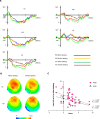Impaired implicit emotion regulation in patients with panic disorder: An event-related potential study on affect labeling
- PMID: 38464769
- PMCID: PMC10921280
- DOI: 10.5498/wjp.v14.i2.234
Impaired implicit emotion regulation in patients with panic disorder: An event-related potential study on affect labeling
Abstract
Background: Panic disorder (PD) involves emotion dysregulation, but its underlying mechanisms remain poorly understood. Previous research suggests that implicit emotion regulation may play a central role in PD-related emotion dysregulation and symptom maintenance. However, there is a lack of studies exploring the neural mechanisms of implicit emotion regulation in PD using neurophysiological indicators.
Aim: To study the neural mechanisms of implicit emotion regulation in PD with event-related potentials (ERP).
Methods: A total of 25 PD patients and 20 healthy controls (HC) underwent clinical eva-luations. The study utilized a case-control design with random sampling, selecting participants for the case group from March to December 2018. Participants performed an affect labeling task, using affect labeling as the experimental condition and gender labeling as the control condition. ERP and behavioral data were recorded to compare the late positive potential (LPP) within and between the groups.
Results: Both PD and HC groups showed longer reaction times and decreased accuracy under the affect labeling. In the HC group, late LPP amplitudes exhibited a dynamic pattern of initial increase followed by decrease. Importantly, a significant group × condition interaction effect was observed. Simple effect analysis revealed a reduction in the differences of late LPP amplitudes between the affect labeling and gender labeling conditions in the PD group compared to the HC group. Furthermore, among PD patients under the affect labeling, the late LPP was negatively correlated with disease severity, symptom frequency, and intensity.
Conclusion: PD patients demonstrate abnormalities in implicit emotion regulation, hampering their ability to mobilize cognitive resources for downregulating negative emotions. The late LPP amplitude in response to affect labeling may serve as a potentially valuable clinical indicator of PD severity.
Keywords: Affect labeling; Emotion regulation; Implicit; Late positive potential; Panic disorder.
©The Author(s) 2024. Published by Baishideng Publishing Group Inc. All rights reserved.
Conflict of interest statement
Conflict-of-interest statement: All the authors report no relevant conflicts of interest for this article.
Figures



Similar articles
-
Neural basis of implicit cognitive reappraisal in panic disorder: an event-related fMRI study.J Transl Med. 2021 Jul 13;19(1):304. doi: 10.1186/s12967-021-02968-2. J Transl Med. 2021. PMID: 34256777 Free PMC article.
-
Current and lasting effects of affect labeling on late positive potential (LPP) amplitudes elicited by negative events.Brain Behav. 2023 Jul;13(7):e3065. doi: 10.1002/brb3.3065. Epub 2023 May 14. Brain Behav. 2023. PMID: 37183558 Free PMC article.
-
Clinical and Neurophysiological Correlates of Emotion and Food Craving Regulation in Patients with Anorexia Nervosa.J Clin Med. 2020 Mar 31;9(4):960. doi: 10.3390/jcm9040960. J Clin Med. 2020. PMID: 32244331 Free PMC article.
-
Late electrophysiological potentials and emotion in schizophrenia: A meta-analytic review.Schizophr Res. 2019 Sep;211:21-31. doi: 10.1016/j.schres.2019.07.013. Epub 2019 Jul 17. Schizophr Res. 2019. PMID: 31324440 Review.
-
Event-related potentials, emotion, and emotion regulation: an integrative review.Dev Neuropsychol. 2010;35(2):129-55. doi: 10.1080/87565640903526504. Dev Neuropsychol. 2010. PMID: 20390599 Review.
Cited by
-
Potential Neurophysiological Markers of Combat-Related Post-Traumatic Stress Disorder: A Cross-Sectional Diagnostic Study.Consort Psychiatr. 2024 Jul 6;5(2):31-44. doi: 10.17816/CP15512. eCollection 2024. Consort Psychiatr. 2024. PMID: 39072002 Free PMC article.
References
-
- Roy-Byrne PP, Craske MG, Stein MB. Panic disorder. Lancet. 2006;368:1023–1032. - PubMed
-
- Kessler RC, Berglund P, Demler O, Jin R, Merikangas KR, Walters EE. Lifetime prevalence and age-of-onset distributions of DSM-IV disorders in the National Comorbidity Survey Replication. Arch Gen Psychiatry. 2005;62:593–602. - PubMed
-
- Gross JJ, editor . Handbook of emotion regulation. 2nd ed. New York (NY): The Guilford Press, 2014.
-
- Cox J, Thakur B, Alvarado L, Shokar N, Thompson PM, Dwivedi AK. Repetitive transcranial magnetic stimulation for generalized anxiety and panic disorders: A systematic review and meta-analysis. Ann Clin Psychiatry. 2022;34:e2–e24. - PubMed
LinkOut - more resources
Full Text Sources

